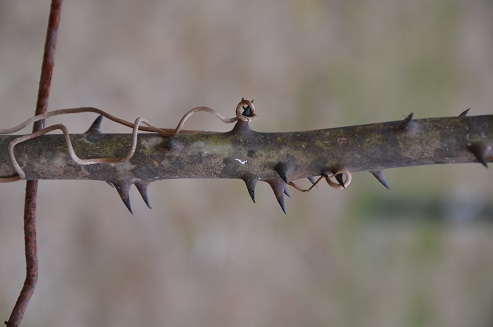The yo-yo thermometer readings make it confusing for the panhandle’s human residents when choosing proper wardrobe selections. With few exceptions, the deciduous plants and trees continue to wait for consistently warmer weather and longer days before covering their trunks and stems with foliage.
The current season’s uncloaking allows for easy examination of the structure and configuration of what will be green and hidden in a few months. This exposure also reveals potentially painful hazards in the native landscape.
Smilax, the sinewy vine, puts up an intimidating barrier to man and beast. Also known as green briar, cat briar and other sometimes graphic terms, the native plant thrives in this area.
In Greek mythology, Smilax was a wood nymph who was transformed into a bramble after the unfulfilled and tragic love of a mortal man. Her final form in this fable was a reflection of her character.
Botanically, smilax is found in tropic to temperate zones. There are about 350 species worldwide and 12 in Florida, with nine being common.
The plant is very vigorous and is equipped with an enviable array of survival traits. It is ready to take every advantage to flourish and inhabit new territory, even under the most unfavorable conditions.
Individual plants can withstand harsh treatment and environments. If burned or mowed to the soil’s surface, they will regenerate from a segmented rhizome root system. Rhizome roots are the subterranean stems which spread roots and runners from its bulbous root nodes.
If pulled up, the rhizome root system will separate at joints. Even the smallest piece of root left in the dirt will generate a new plant.
Smilax has the additional resource of extra-floral nectaries, nectar-producing glands physically separate from the flowers. These nectaries may function as an organ for the plant to rid itself of metabolic wastes and/or to attract beneficial insects for pollination and defense.
Ants are especially attracted to the extra-floral nectaries in smilax and frequently establish mounds close by. The ants defend the smilax from herbivores which eat the leaves, if they can get past the thorns.
In addition to spreading by its root system, smilax produces berries which contain a seed. The berries appear in late summer or early autumn and ripen to a blue-black color.
The berries are usually consumed in winter after the smilax loses it leaves. Birds and animals will deposit the seed at a new site. Best chances for the seed to germinate occur after it is exposed to a freeze, as the panhandle has recently experienced.
Smilax vines will climb up trees, fence post, and any other stationary object to get better sun exposure. They have been known to reach over 30 feet in height, but do not tend to kill their host by shading out the sun.
Ants commonly use the vines as a readily available pathway on foraging trips. Ants may establish colonies in above ground locations, courtesy of smilax vines which provide a wide-reaching pathway.
Smilax can be controlled with some broadleaf herbicides, but repeated applications will be necessary. The best time to apply herbicides is in the early spring when the first leaves appear.
Once the leaves return, smilax can be difficult to identify and control, hidden in all the common greenery.
To learn more about smilax in Panhandle Florida read the Key to Nine Common Smilax Species of Florida or contact your local UF/IFAS Extension Office.
- Get Your Trees Ready For The Winds of October - October 8, 2019
- Feeding Caterpillars Aren’t Always Cute - August 10, 2018
- Wild Azaleas - May 23, 2018

